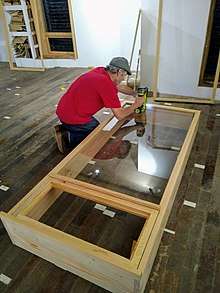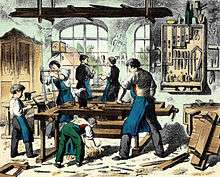Joiner
A joiner is an artisan and tradesperson who builds things by joining pieces of wood, particularly lighter and more ornamental work than that done by a carpenter, including furniture and the "fittings" of a house, ship, etc.[1] Joiners may work in a workshop, because the formation of various joints is made easier by the use of non-portable, powered machinery, or on job site. A joiner usually produces items such as interior and exterior doors, windows, stairs, tables, bookshelves, cabinets, furniture, etc. In shipbuilding a marine joiner may work with materials other than wood such as linoleum, fiberglass, hardware, and gaskets.[2]
 A joiner prepares a window for installation | |
| Occupation | |
|---|---|
Activity sectors | Construction |
| Description | |
Education required | Vocational school |
The terms joinery and joiner are in common use in the UK, Australia, and New Zealand. The term is not in common use in North America, although the main trade union for American carpenters is called the United Brotherhood of Carpenters and Joiners of America.
In the UK, an apprentice of wood occupations could choose to study bench joinery or site carpentry and joinery. Bench joinery is the preparation, setting out, and manufacture of joinery components while site carpentry and joinery focus on the installation of the joinery components, and on the setting out and fabrication of timber elements used in construction.
History
In the history of technology in Europe, joinery was the medieval development of frame and panel construction, as a means of coping with timber's movement owing to moisture changes. Framed panel construction was utilized in furniture making. The development of joinery gave rise to "joyners", a group of woodworkers distinct from the carpenters and arkwrights (arks were an intermediate stage between a carpenter's boarded chest and a framed chest).
The original sense of joinery is only distantly related to the modern practice of woodworking joints, which are the work of carpenters. This new technique developed for several centuries, and joiners started making more complex furniture and paneled rooms. Cabinetmaking became its own distinct furniture-making trade too, so joiners (under that name) became more associated with the room paneling trade.
By the height of craft woodworking (late 18th century), carpenters, joiners, and cabinetmakers were all distinct and would serve different apprenticeships.
Woodworking professions

The Institute of Carpenters recognizes the following professionals working in wood:
- Carpenters
- Furniture and cabinet makers
- Boat builders (woodworking skills)
- Joiners
- Shopfitter
- Structural post and beam carpenters (timber framing)
- Wheelwrights
- Wood carvers
- Wood turners
 Illustration of an 1880s joiner's shop in Germany
Illustration of an 1880s joiner's shop in Germany
See also
| Wikimedia Commons has media related to Joiners. |
- Jointer, a woodworking tool used to flatten boards so that they may be attached or joined
- CCG Profiles
References
- "joiner, n. 2. a." Oxford English Dictionary. 2nd. ed. 2009. CD-rom.
- Canadian Classification and Dictionary of Occupations. 6th ed. Ottawa: Employment and Immigration Canada, Occupational and Career Information Branch, 1971. 756. Print.
External links
- Institute of Carpenters
- British Woodworking Federation – a not-for-profit woodworking body advice on joinery in the UK
- The art of joinery: 17th-century case furniture in the American Wing, a fully digitized exhibition catalog from The Metropolitan Museum of Art